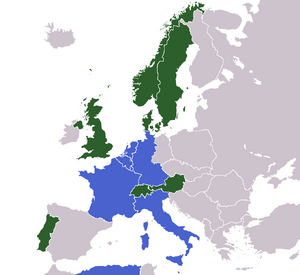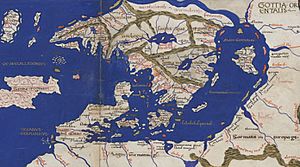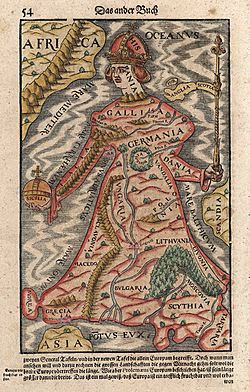Continental Europe facts for kids
Continental Europe, also referred to as mainland Europe or simply the Continent (particularly by Britons, Azoreans, Madeirans, Balearic and Canary Spaniards, Icelanders and other European island nations, and peninsular Scandinavians), is the continent of Europe, explicitly excluding the islands of Europe.
The most common definition of continental Europe excludes the Greek Islands, Malta, Sicily, Sardinia, Corsica, the Balearic Islands, Iceland, Ireland, and the United Kingdom and its dependencies. Most definitions extend the boundaries of the continent to its standard boundaries: the Ural Mountains, the Ural River, the Caspian Sea, and the Caucasus Mountains.
Contents
Use in the United Kingdom

In the United Kingdom, the Continent is widely and generally used to refer to the mainland of Europe. In addition, the word Europe itself is also regularly used to mean Europe excluding the islands of Great Britain, Iceland, and Ireland (although the term is sometimes used to refer to the European Union).
Derivatively, the adjective continental refers to the social practices or fashion of continental Europe as opposed to those of Britain. Examples include breakfast and, historically, long-range driving (before Britain had motorways) often known as Grand Touring. Continental Europe, when compared to Britain, has numerous defined differences both cultural and tangible. The use of Civil rather than Common Law, different electrical plugs, different time zones for the most part, a different currency, driving on the right, and using the metric system exclusively are a small selection.
Especially in Germanic studies, continental refers to the European continent excluding the Scandinavian peninsula, Britain, Ireland, and Iceland. The reason for this is that although the Scandinavian peninsula is attached to continental Europe by Karelia and the like, it is usually reached by sea, not by land (which would require travelling north as far as Tornio at the 66th parallel north). Kontinenten (the Continent) is a vernacular Swedish expression that refers to the area excluding Sweden, Norway, and Finland but including Denmark (even the Danish archipelago) and the rest of continental Europe. In Norway, similarly, one speaks about Kontinentet as a separate entity, usually referring to Germany, France, Italy, Spain, Portugal, the Benelux countries, and such.
Mediterranean and Atlantic islands
The Continent may sometimes refer to the continental part of Italy (excluding Sardinia, Sicily, etc.), the continental part of Spain (excluding the Balearic islands, the Canary Islands, Alboran, etc.), the continental part of France (excluding Corsica, etc.), the continental part of Portugal (excluding the Madeira Islands and Azores), or the continental part of Greece (excluding the Ionian Islands, the Aegean Islands, and Crete). The term is used from the perspective of the island residents of each country to describe the continental portion of their country or the continent (or mainland) as a whole.
Images for kids
-
The European continent's eastern half in Russia, as bounded by the Caucasus Mountains to the south, and which extends as far as the Ural Mountains
See also
 In Spanish: Europa continental para niños
In Spanish: Europa continental para niños





